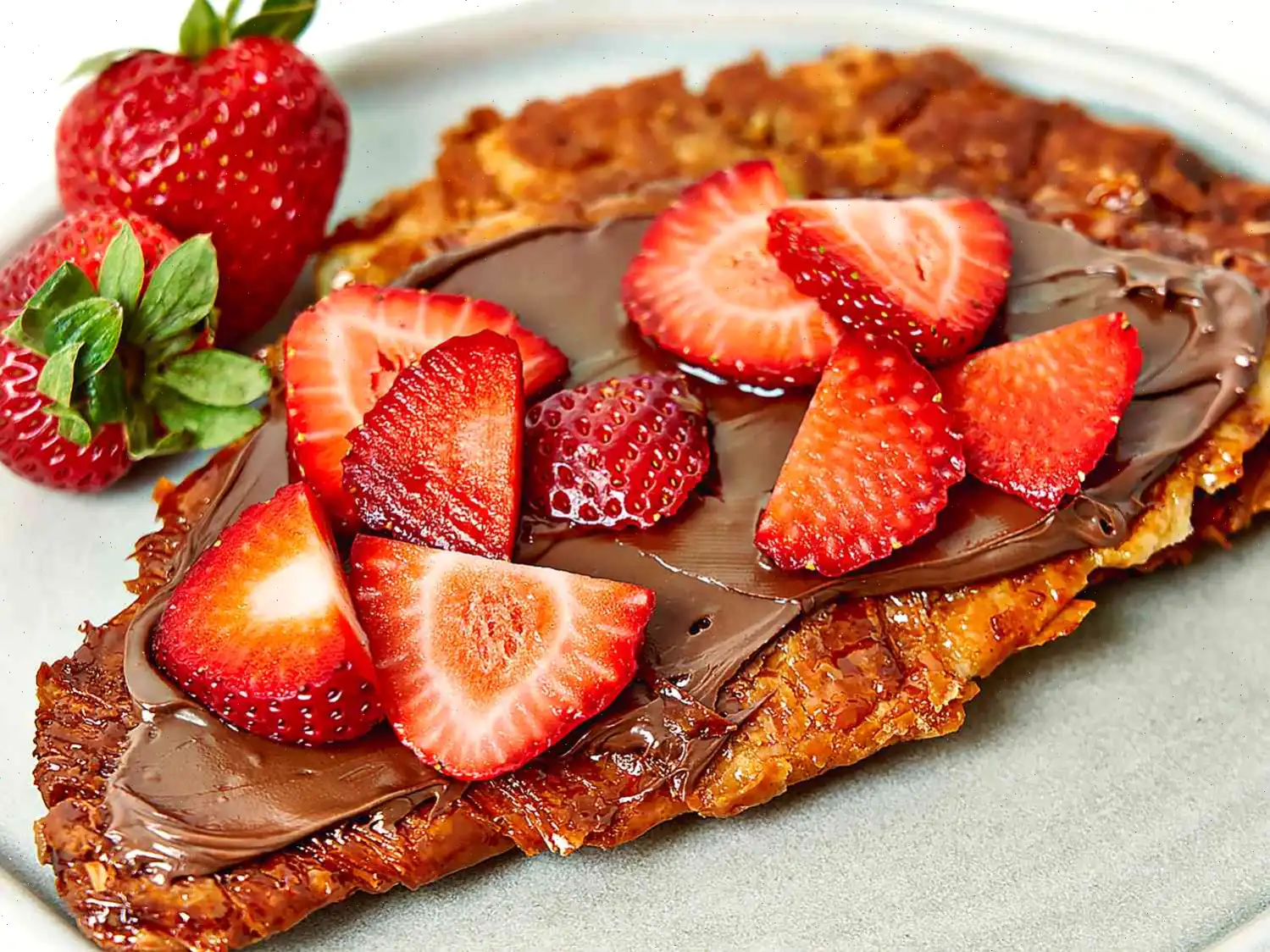
Flat Croissant with Nutella and Berries Recipe
Ingredients
- 1 large croissant
- 1 1/2 tablespoons butter
- 1 tablespoon honey
- 1 tablespoon chocolate hazelnut spread (such as Nutella)
- 1/4 cup fresh berries (sliced strawberries, blueberries, or raspberries)
Directions
Step 1: Use a rolling pin or your hands to flatten the croissant to about 1/4-inch thickness.
Step 2: Heat the butter in a medium skillet over medium heat until it melts.
Step 3: Place the croissant in the skillet, bottom side down. Press it gently with the bottom of a smaller skillet or saucepan to help it brown evenly. Cook for about 3 minutes or until lightly browned.
Step 4: Drizzle the honey evenly over the croissant and add the remaining butter to the skillet.
Step 5: Flip the croissant over and press it again, cooking for an additional 2 minutes, until the top side is lightly browned and toasted.
Step 6: Remove the croissant from the skillet and place it on a plate to cool slightly.
Step 7: Spread a generous layer of Nutella over the croissant and top with fresh berries to your liking.
Nutrition Facts (per serving)
| Calories | 1078 |
|---|---|
| Total Fat | 69g |
| Saturated Fat | 33g |
| Cholesterol | 136mg |
| Sodium | 771mg |
| Total Carbohydrate | 102g |
| Dietary Fiber | 10g |
| Total Sugars | 46g |
| Protein | 18g |
| Vitamin C | 12mg |
| Calcium | 117mg |
| Iron | 7mg |
| Potassium | 509mg |
* Percent Daily Values are based on a 2,000 calorie diet. Your daily values may be higher or lower depending on your calorie needs.
This simple yet indulgent dish features a deliciously pan-toasted croissant, spread with creamy Nutella and topped with fresh, vibrant berries. It serves as a perfect snack, sumptuous breakfast, or even a delightful dessert. In this article, we'll dive into the history of the croissant, explore its regional variations, compare it with similar dishes, and uncover some interesting facts about this sweet treat.
Origin and History
The croissant, as we know it today, traces its origins to Vienna, Austria, although it is commonly associated with French cuisine. The iconic crescent-shaped pastry was inspired by the Turkish flag after the Ottoman Empire's failed attempt to invade Vienna in 1683. Legend says that Viennese bakers created the pastry to celebrate the victory, symbolizing the crescent moon. In the early 19th century, when Austrian princess Marie Antoinette married the French king Louis XVI, she introduced the croissant to France, where it became a staple of French bakeries.
Regional Variations
While the classic croissant is a flaky, buttery pastry found throughout France, different regions have their own takes on the treat. In Paris, the croissant is often light and airy, with a delicate crispness. In contrast, the croissant in other parts of France, such as in Lyon or Provence, may be a bit denser or sweeter, sometimes incorporating ingredients like almond paste or honey. This "flat croissant" recipe, with its toasted texture and Nutella spread, represents a more modern twist, blending classic French tradition with contemporary flavors.
How It Differs from Similar Dishes
Though the flat croissant with Nutella and berries shares some similarities with dishes like Danish pastries or tarts, it stands apart in its simplicity and quick preparation. Unlike the traditional croissant, which requires careful layering of dough and butter, the flat croissant is pressed out to a thin layer, then toasted in a pan. The addition of Nutellaspread over the warm croissantadds a rich, chocolate-hazelnut flavor that complements the slight crunch of the toasted croissant. The fresh berries, often strawberries, raspberries, or blueberries, provide a burst of freshness, balancing the richness of the Nutella.
Where It's Typically Served
In cafs and bakeries around the world, croissants are often served as a breakfast pastry or snack. The flat croissant with Nutella and berries, however, is a bit of a modern creation, commonly found at brunch spots or cafs with a focus on contemporary, indulgent breakfasts. It's also popular as a simple dessert in casual dining establishments, offering a quick but decadent treat. Given its versatility, this dish is easy to make at home and can be served as a special treat for any occasion.
Interesting Facts
- The Nutella brand, founded in 1964, has become synonymous with chocolate hazelnut spread worldwide. Nutella's global popularity has led it to be a key ingredient in numerous sweet and savory dishes.
- In some regions, the croissant is traditionally eaten with a cup of hot chocolate, though many opt for coffee or tea in modern settings.
- Despite being a French pastry, the word "croissant" actually comes from the French word for "crescent," which refers to the shape of the pastry, linking back to its origins in Vienna.
- Fresh berries, a key topping in this recipe, are known for their high levels of antioxidants, adding a healthful aspect to this indulgent dish.
Conclusion
The flat croissant with Nutella and berries is a delightful fusion of traditional French pastry with modern flavors. Whether you're looking for a quick breakfast or a sweet afternoon treat, this dish provides a satisfying blend of textures and tastes. Its simplicity makes it accessible to prepare at home, while its flavors make it a crowd-pleaser for any gathering. So, the next time you're in the mood for something sweet, consider this easy-to-make recipe!
FAQ about Flat Croissant with Nutella and Berries Recipe
Comments
Anna Perez
12/14/2022 08:48:15 PM
Oh my goodness! Nutella and strawberries have always been a go-to snack for me, but this takes it to another level. Absolutely fantastic. I love adding a sprinkle of Maldon sea salt on top - it enhances the sweetness of the berries and adds a delightful touch.








